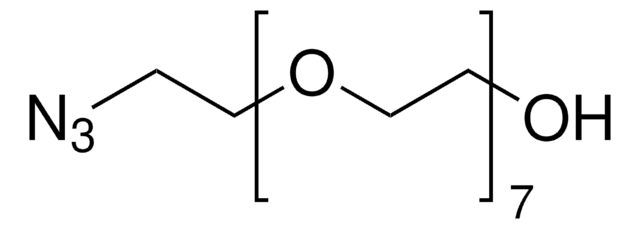726176
Methoxypolyethylene glycol azide
PEG average Mn 20,000
Synonym(s):
Polyethylene glycol, α-Methoxy-ω-azido-PEG, O-(2-Azidoethyl)-O′-methylpolyethylene glycol, PEG-Azide, mPEG Azide
About This Item
Recommended Products
form
lumps
mol wt
PEG average Mn 20,000
Ω-end
azide
α-end
methoxy
storage temp.
−20°C
Looking for similar products? Visit Product Comparison Guide
Storage Class Code
11 - Combustible Solids
WGK
WGK 3
Flash Point(F)
Not applicable
Flash Point(C)
Not applicable
Personal Protective Equipment
Certificates of Analysis (COA)
Search for Certificates of Analysis (COA) by entering the products Lot/Batch Number. Lot and Batch Numbers can be found on a product’s label following the words ‘Lot’ or ‘Batch’.
Already Own This Product?
Find documentation for the products that you have recently purchased in the Document Library.
Articles
Circulatory half-life is a key success factor for new drugs. In this respect, PEGylation or PEG-ing—the modification of potential candidates ranging from non-peptidic small molecules to peptides and proteins, antibody fragments, aptamers, and saccharides or oligonucleotides with polyethylene glycol chains—offers numerous advantages.
Circulatory half-life is a key success factor for new drugs. In this respect, PEGylation or PEG-ing—the modification of potential candidates ranging from non-peptidic small molecules to peptides and proteins, antibody fragments, aptamers, and saccharides or oligonucleotides with polyethylene glycol chains—offers numerous advantages.
Circulatory half-life is a key success factor for new drugs. In this respect, PEGylation or PEG-ing—the modification of potential candidates ranging from non-peptidic small molecules to peptides and proteins, antibody fragments, aptamers, and saccharides or oligonucleotides with polyethylene glycol chains—offers numerous advantages.
Circulatory half-life is a key success factor for new drugs. In this respect, PEGylation or PEG-ing—the modification of potential candidates ranging from non-peptidic small molecules to peptides and proteins, antibody fragments, aptamers, and saccharides or oligonucleotides with polyethylene glycol chains—offers numerous advantages.
Our team of scientists has experience in all areas of research including Life Science, Material Science, Chemical Synthesis, Chromatography, Analytical and many others.
Contact Technical Service






